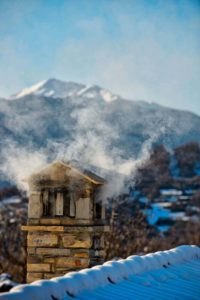Fireplace Smoking Problems
The last thing you want to experience on a cold winter’s night is a smoky fireplace. A smoky chimney doesn’t have to be wafting clouds of smoke out into your room. It can also smell strongly of smoke, cause respiratory distress, and produce excessive smoke inside the fireplace that hides the flames. A smoky fireplace can take on different forms, but one thing is for certain—it shouldn’t occur at all.
Reasons Your Chimney Smokes
Draft Problems
- Your chimney should vent the smoke from your fireplace, but to do so requires an updraft to carry smoke and gases up and out of the house. The heat from the fireplace should create the push the air needs to rise, but if the chimney system is competing with other draft-producing appliances in the house, it may not vent properly.
- Troubleshoot: Crack a window or door in another part of the house. Do not run large appliances or ceiling fans while the fireplace is going or when fireplace doors are open.
Airflow Problems
- It may be that you have an obstruction in your flue. Your chimney may have a creosote buildup that has become a dangerous obstruction. It may be filled with debris, or the damper may be stuck in an engaged position, closing off the flue opening and preventing airflow.
- Troubleshoot: Look into your chimney with a mirror to check for obvious obstructions. If the flue is closed to airflow, DO NOT ATTEMPT A FIRE until it has been assessed by a certified chimney sweep.
Incorrect Fuel
- Burning the wrong type of fuel in your fireplace can cause smoke problems. You should only burn properly seasoned wood in your fireplace. It should be cut and dried so that it burns cleanly. Green/fresh wood will smoke more, as well as leaves, pine cones, pine needles, clothes, and trash.
- Troubleshoot: Plan ahead and cut or buy wood with adequate time for it to season. Check the wood’s dryness by inspecting it visually before burning.
Cold Chimney
- If your chimney is cold, your fire is battling a great deal of cold air. The cold air in your chimney will fall as the warm air from your fire attempts to rise. The cold air will win, push smoke into your house, and make it difficult to light the fire and keep it lit.
Troubleshoot
- Prime your chimney by lighting a rolled newspaper and burning it completely while holding it at the mouth of the chimney. This small amount of heat slowly warms the air in the chimney. By the time the newspaper is burned completely, your chimney should be ready to vent your fire.
Contact Us
There are other reasons that your chimney may not be venting properly. If you’ve attempted to troubleshoot and still get the same results, it’s a good idea to stop using your fireplace until a professional can assess it. There may be unseen problems with your chimney system that can put your family and home at risk if not addressed. Schedule a chimney inspection with Chief Chimney Services, and you won’t be waiting long. Chief Chimney Services offers the best services in the Suffolk County Area—and in a timely manner. Call us today at 631-863-2460 or schedule an appointment online now.

